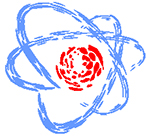Speaker
Ms
Martyna Wojciechowska
(Faculty of Chemistry, University of Wroclaw)
Description
The phenomenon called ferroelectricity was discovered in the solid state (Rochelle salt) in 1920 by Joseph Valasek. Since then the nonlinear optical (NLO) and nonlinear dielectric (ferroelectric) materials have become more and more attractive as they may be widely used in advanced laser technology, optoelectronics, optical storage and information processing, as well as mechanical energy transfer. Accordingly, a significant number of organic–inorganic hybrid materials based on metal (Pb, Bi, Sb, Sn)–halide units have been prepared and studied recently. Haloantimonates(III) and halobismuthates(III) of the general formula RaMbX3b+a, (where R denotes organic cations, M stands Sb(III) or Bi(III) and X = Cl, Br, I) have attracted more attention among scientists around the world as they combine facile synthesis with the desired electrical and optical properties. [2] There is a huge diversity of chemical compositions among halantimonates(III) and halobismuthates(III), nevertheless, ferroelectricity is limited only to few of them, e.g. RMX4, R3M2X9, R2MX5 and R5M2X11. Many reports have been devoted to the crystals with the R3M2X9 composition, which are characterized by three terminal halogen atoms and three bridging ones. The [MX6] octahedra can form either the infinite one-dimensional chains, two-dimensional layers, discrete bioctahedral or four-octahedral units [M4X18]6-. In spite of a wide variety of the anionic forms the ferroelectric properties were found to appear only in salts characterized by two-dimensional anionic layers. The cations (small and mobile, like methyl-, dimethyl- and trimethyl-ammonium) which occupy the cavities inside the layers in the ferroelectric phase of these systems are expected to contribute to the spontaneous polarization. In the search for new polar crystals we have extended our studies on halogenoantimonates(III) and halogenobismuthates(III) embedding in the structure the saturated pentagonal heterocycle cation like pyrrolidinium. In this presentation the thermal, structural and dielectric properties of tris(pyrrolidinium) nonachlorodiantimonate(III): (C4H10N)3[Sb2Cl9] within a wide temperature range will be discussed. To throw more light on the molecular mechanism of the high temperature phase transitions the infrared and 1H NMR studies were carried out in a wide temperature range.
[1] Dawber M., Rabe K. M., Scott J. F.: Rev. Mod. Phys.2005, 77, 1083
[2] Sobczyk L., Jakubas R., Zaleski J.: Pol. J. Chem. 1997; 71, 265
[3] Zaleski J., Pawlaczyk Cz., Jakubas Ryszard, Unruh H. G.: J. Phys.: Condens. Matter 2000, 12, 7509
[4] Zaleski J., Pietraszko A.: Acta Cryst. 1994, B25, 287
[5] Bujak M., Zaleski J.: Crystal Engineering 2001, 4, 241
Primary author
Ms
Martyna Wojciechowska
(Faculty of Chemistry, University of Wroclaw)
Co-authors
Dr
Anna Gagor
(ILTSR, PAS)
Dr
Anna Piecha-Bisiorek
(Faculty of Chemistry, UWr)
Prof.
Jan Baran
(ILTSR, PAS)
Prof.
Piotr Zielinski
(IFJ PAS)
Prof.
Ryszard Jakubas
(Faculty of Chemistry, UWr)

